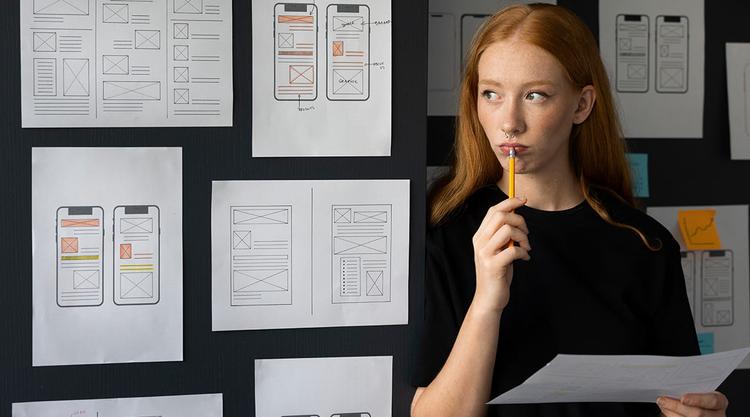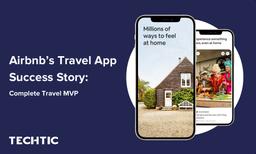Common UX Design Mistakes to Avoid
Sector: UI/UX
Author: Kishan Gediya
Date Published: 06/10/2021

Contents
- Top 25 most common UX mistakes designers make and How to avoid them
- Considering UX only in the Initial Parts of the Project
- Adding too Much Content
- Improper Navigation
- Not Adopting Simplicity
- Not including Design Thinking
- Ignoring Usability
- Lots of Animations
- Poor Contrast
- Poor Choice of Fonts
- Imbalance between Design, Features, and Content
- Not Equally Prioritizing Functionality and Aesthetics
- Hopping on each Bandwagon
- Not Considering Responsive Design
- Working for Search Engines and Not Users
- Ignoring the Value of Content
- Creating Multi-faceted and Complicated User Interfaces
- Dreadful Onboarding and Sluggish First Impression
- Blindly Copying the Work of Close Competitors
- Over Focusing on Updates and Push Notifications
- Gathering Feedbacks and Working on them too Soon
- Over Utilization of Popups
- Over Emphasis on Being Engaging
- Utilization of Scroll Hijacking
- Similar Design on Diverse Platforms
- Designing for Yourself
- Conclusion
Many startups and heavyweight businesses across the globe have invested in designing web and mobile applications. Their concepts were great and might have given competitors a run for their money. However, in the long run, they proved unsuccessful and had to shut down their businesses.
One of the significant reasons behind their failure was the poor user experience. The reality is that even today, many apps offer their users a tough time figuring out which Call-To-Action (CTA) button did what. Some of them have privacy challenges, and some take a lot of time to load. And the users quickly skip such applications.
That is why user experience plays a critical role in making or breaking your business. With 2,890,000 free apps and 114,000 paid apps accessible on the Google Play Store in 2021, getting the user to install your application is in itself a massive task.
Around 88 percent of online shoppers don’t return to a web portal or app after having an awful user experience.
Therefore, you necessitate an intelligent app concept, an open market ready for your idea, a result-oriented strategy to make the most of your project, and last but not least, a sharp User Experience to be successful.
So without talking more, let’s explore the –
Top 25 most common UX mistakes designers make and How to avoid them
1) Considering UX only in the Initial Parts of the Project
Most UX designers don’t focus on user experience as a continuous process and think it needs attention only in the initial parts of the project.
However, most leading apps, including Dropbox, Snapchat, and Instagram, have worked on user experience iteratively with constant user opinion and feedback.
Working on real-time user feedback and an in-depth competitor analysis assist in avoiding a lot of UX design challenges throughout the web and mobile app development stages.
Even after your app implementation and deployment, working on feedback provided by actual users makes you understand what functionalities your app is lacking.
2) Adding too Much Content
Content overload negatively impacts design. Direction signs on the road, for instance, are good examples of content overload.
They showcase a lot of multi-faceted information in a limited space which makes them tough to follow at a glimpse. However, working on user experience and design thinking aspects can help you trim down content distractions.
3) Improper Navigation
The belief that users will discover how to use the app is a common user experience mistake to avoid. The navigation should be entirely clear, and it should meet the user’s likelihood. If they frequently get puzzled by the process, they will switch elsewhere.
You must have viewed this – a website or an app have numerous icons and links on their main page. It looks awful. This is due to the fact that our short-term memory can hold merely a few items. With minimal menu items, your users can better explore the displayed products. Each time you reduce a menu item, the other products become more distinguished. So, work on limiting your navigation to minimal products and enhance their visibility.
4) Not Adopting Simplicity
Today’s favorite apps have a pretty simple user interface, as most users prefer solutions that work smoothly and swiftly.
Evaluate whether the functionalities offered by your app have a definite objective. Can it be done with a more effortless approach? If confident, then think about your existing features and redesign them to make things simpler.
Airbnb is one of the top mobile applications that found success because of a simple user interface. The Airbnb app effectively simplifies its customer journey without negotiating on innovativeness and offered features.

5) Not including Design Thinking
UX design is an in-progress journey to help your users. Compelling mobile experiences pursue across all the stages of design thinking. So, if you don’t include design thinking, you would end up with a poor UX design experience.
The five stages of Design Thinking enable defining, empathizing, ideating, prototyping, and testing at all involved design steps.
They may not be chronological and can even work in a defined or iterative cycle. Not following these stages will shun your objective to understand your product’s audience and end goals.
6) Ignoring Usability
Why do all web portals or applications look similar?
The initial impression is essential to attract a new user. However, a practical user experience with enhanced Usability is equally significant as it will bring back your users for repeat purchase.
You will be shocked to hear that around 70 percent of digital businesses that fail do so due to Poor Usability.
That’s the reason why ignoring usability could become one of your biggest UX mistakes to avoid.
7) Lots of Animations
When should you use and apply animations?
Animations are applied to make stuff sound natural. However, if it makes the user experience sluggish, time taking and pointless – it is better to avoid it.
8) Poor Contrast
Are design interfaces annoying your users?
At times contrast makes a design come across as superior in looks. However, it doesn’t add value if your users can’t comprehend them easily. That would be the worst UX mistake to make, avoid it.
9) Poor Choice of Fonts
Full of Style Vs. Clear fonts?
A significant part of design consists of typography. Enabling typography optimizes clarity, user-friendliness and boosts Usability. Poor fonts have no significance across the user experience.
10) Imbalance between Design, Features, and Content
Negative space is vital to put off the user experience from looking devastating. A thriving app balances design, features, and content.
It is essential to understand that your app needs sufficient space to emphasize design components to display to your users. Attempting to showcase everything by using up all your screen space with content will only amplify your bounce rate.
A clear example to discover is the collapse of Google Wave. While at the outset, the app attracted numerous users, it failed in the long run as its interface had an imbalance of design, content, and features.
11) Not Equally Prioritizing Functionality and Aesthetics
Your application should drive a precise balance amid functionalities and applied creativity. Correspondingly, your app should not prioritize functionality and negotiate on aesthetics. If your app merely focuses on the involved functions, it may turn off your users and induce them to switch.
Similarly, if you purely focus on creativity and not functionality – this is the conflict of what you want with your app. Your app or portal must be visually appealing, aesthetically gratifying, creative, and have exclusive functionalities to enhance your brand loyalty.
12) Hopping on each Bandwagon
Trends approach, draw closer and even go. Just when you assume you have dominated UX, fresh trends come up and force you to rethink your set tactics. As an app owner, you must evaluate each trend and remember you can’t implement them all.
Do not hop on new UX trends for the reason that everyone will be doing the same. Please reassess your performance indicators and evaluate whether the transformation applies to your app or not.
Many trends might not have enough statistics to support them and could waste your funds and time. Delve into a trend watchfully to ensure it is the precise approach for your application.
13) Not Considering Responsive Design
Responsive design is not a trend and is an integral component of a winning application. However, we still come across applications and portals that do not entirely accept responsive design elements.
Around 94 percent of people evaluate web portals on responsive design. And so, a mobile-first design must be your top priority.
Not crafting your website or application with a responsive structure can make it impractical for your users to benefit from their experiences when browsing from a smartphone.
So, do not limit your users with this straightforward and common mistake. Redesign your application to prioritize responsiveness for the most favorable user experience.
14) Working for Search Engines and Not Users
In the period of ever-mounting digital competition, it is no revelation that website owners are obsessed with their precise keyword rankings. This focus on search engine rankings makes the crucial UX mistake of avoiding a search engine’s primary preference, which is the user base.
While it is fundamental to design your web portal with SEO guidelines, your final purpose must be delivering the best user experience. If done precisely, this will, in response, boost your search engine page ranks. It is significant to design your portal or application for humans first and then search engines.
15) Ignoring the Value of Content
Do not undervalue the significance of your content. Your applications require superior quality content to optimize the user experience.
Even here, the spotlight of your content should be on the targeted users and ensure the content applies to your brand’s core message.
It should offer helpful insights to your customer base. And you should also follow SEO guidelines to ensure higher page ranks on the SERP.
16) Creating Multi-faceted and Complicated User Interfaces
An effective user interface offers precise information without negotiating on the content and context.
So, you should thoroughly check and test every user interface before introducing it in the final product.
Every interface on the application should be an utmost three touch-points away. A multi-faceted or complex flow of information will lead your user to switch.
17) Dreadful Onboarding and Sluggish First Impression
Whether it is a client meeting, giving a job interview, using a web portal, or a mobile application, the first few minutes of the UX will decide if the involved stakeholders will connect with you or not.
In most scenarios, a comprehensive yet crisp application onboarding procedure is essential, making precise all the app functions to the users. However, overexerting this part will lead to steering them away from your application, making it a loss-making UX mistake.
Some applications will puzzle the users if they are not spontaneous. So, precise beta testing will help resolve these challenges a user will undergo and enhance the app’s first impression. However, currently, only 55 percent of organizations opt for any UX testing procedures.
18) Blindly Copying the Work of Close Competitors
Steve Jobs, an American business magnate and co-founder of Apple Inc once notably said, “We have always been barefaced about thieving great ideas.”
Copying is the easiest thing to do and might entice you to imitate your close competitors blindly for quick success.
However, UX designers should remember that getting your applications too similar to the competition will demotivate most users and your loyal customers.
Your users always look for innovations, and a copied application with identical features will negatively impact your brand name.
Sure, you can have some functionality parallel to the competition. However, your application requires having unique features and your custom signature at the end.
19) Over Focusing on Updates and Push Notifications
Reminding users that they have received a new message or earn rewards would continue their loyalty. But too many updates and push notifications will lead your users to be frustrated.
Further, sending notifications about haphazard news or updates would create issues and be considered as a phisher.
However, while you don’t require pushing updates too frequently, you cannot overlook the comments the users convey in the app store and communicate updates to them smartly.
20) Gathering Feedbacks and Working on them too Soon
When you launch a web portal or an application, you are in a hurry to gather user feedback. However, there is always a precise time for everything, correct?
We want to say that give your users some time before you initiate with soliciting feedback. This scenario will assist them in making up their mind about the eminence of your product and whether it is worthy of appreciation or not.
Don’t ever agitate users while they are engaging with your application or web portal.
21) Over Utilization of Popups
We won’t contradict it. Pop-ups are a valuable tool for digital marketers.
They have a demonstrated reputation for lead generation and boosting blog subscriptions.
However, Google published a soft warning in 2016 that web pages with pop-ups could impact a website’s search rankings. And as per Google’s 2017 update, it wanted to grip these violators.
Google took these actions for those websites that had visually concealed their content by a pop-up. These updates intend to get better on the mobile search experiences, and users can easily access content without unwanted pop-ups.
22) Over Emphasis on Being Engaging
Websites require looking upright and having interacting elements. However, users are not always happy with the sites that persuade and emphasize engagements.
- Animation and Continuous Music: Users are unable to stand them.
- Heavy Images: These take more loading time and irritate users.
23) Utilization of Scroll Hijacking
Scroll hijacking is another technique that is getting popular across the web. Websites that enable this functionality can take control of their web page scrolling. When visitors bump into it, they lose control of the web page scroll and get puzzled about the behavior of the site. It is a risky scenario and can impact Usability. And now you know that poor impact on Usability is one of the biggest UX mistakes.
Many websites are successful with scroll hijacking. However, not everybody has found it fruitful. Apple’s sites are successful with scroll hijacking and facilitating superior-resolution images of their varied products. However, even Apple must have faced challenges and solved them flourishingly.
Without precise testing, UX designers have no means of discovering if scroll hijacking will work, and making guesses is time and again pricey for application owners.
24) Similar Design on Diverse Platforms
Users have regular routines and inclinations. If your app works differently on diverse platforms, the users will be puzzled.
For instance, iOS users find it tough to utilize most of the apps on the Android platform.
25) Designing for Yourself
Design and development teams can often form rigid outlooks about the product they are developing. This scenario is not the right approach.
UX designers should avoid their preferences conflicting with user needs. As a design professional, it’s significant for you to understand that you are designing a product with a specific user base involving precise requirements and demands.
You should enable user-centric design practices across the complete design process to stop evolving the design project as per the professionals who craft them.
Conclusion
So, there you go. We fruitfully discussed twenty-five common UX mistakes that you can better avoid while designing an app project. If you feel you have some more recommendations for UX designers out there, do drop your valuable comments.
Techtic Solutions has an extensive pool of UI/UX designers, developers, and specialist teams who clearly understand the significance of user experience in diverse web and mobile app development projects. Our proficient teams have extensive experience, and our teams have successfully delivered varied UI/UX projects.
To discover more about UI/UX Design and Development Services from Techtic, feel free to connect with us today!
To discover more about UI/UX Design and Development Services from Techtic, feel free to connect with us today!
Latest Tech Insights!
Join our newsletter for the latest updates, tips, and trends.




